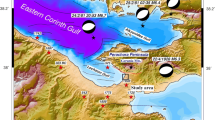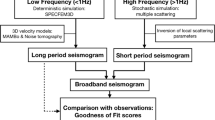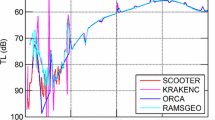Abstract
To investigate the nature of Pn propagation, we have implemented the spectral-element method (SEM) for vertically and laterally varying media with and without attenuation. As a practical measure, essential features of the Pn waves are distilled into seismic attributes including arrival times, amplitudes and pulse frequencies. To validate the SEM simulations, we first compare the SEM results with reflectivity calculations of Braile and Smith (Geophys. J.R. Astr. Soc. 40, 145–176, 1975) and then to the asymptotic results of Červený and Ravindra (Theory of Seismic Headwaves, University of Toronto Press, pp. 235–250, 1971). Models with random, laterally varying Moho structures are then simulated, where the amplitude and pulse frequency characteristics are found to be stable to small Moho interface perturbations. SEM calculations for models with different upper-mantle velocity gradients are next performed where it is found that interference effects can strongly influence the Pn amplitudes and pulses frequencies. For larger-scale, laterally varying structures, SEM models similar to that found along the Hi-CLIMB array in Tibet are then performed. It is observed that large-scale structures, along with small-scale structures, upper-mantle velocity gradients and attenuation, can all significantly affect the Pn attributes. Ambiguities between upper-mantle velocity gradients and attenuation are also found when using Pn amplitudes and pulse frequency attributes. These ambiguities may be resolved, to some degree, by using the curvature of the travel times at longer regional distance, however, this would also be complicated by lateral variability.











Similar content being viewed by others
References
Aki, K., and Richards, P.G. (2002) Quantitative Seismology. University Science Books.
Avants, M., Lay, T., Xie, X.B., and Yang, X. (2011). Effects of 2D random velocity heterogeneities in the mantle lid and Moho topography on Pn geometric spreading. Bull. Seism. Soc. Am. 101, 126–140.
Braile, L.W., and Smith, R.B. (1975). Guide to the interpretation of crustal refraction profiles. Geophys. J.R. Astr. Soc. 40, 145–176.
Červený, V., and Ravindra, R. (1971). Theory of Seismic Head Waves. University of Toronto Press, pp. 235–250.
Chew, W.C. (1990). Waves and Fields in Inhomogeneous Media. Nostrand Reinhold Book Co., pp. 57–66.
Dahlen, F.A., Tromp, J. (1998). Theoretical Global Seismology. Princeton University Press, pp. 327–350.
Griffin, J.D., Nowack, R.L., Chen, W. P. and Tseng, T. L. (2011). Velocity structure of the Tibetan lithosphere: Constraints from P-wave travel times of regional earthquakes. Bull. Seism. Soc. Am. 101, 1938–1947.
Helmberger, D., and Vidale, J.E. (1988). Modeling strong motions produced by earthquakes with two-dimensional numerical codes. Bull. Seism. Soc. Am. 78, 109–121.
Hill, D.P. (1971). Velocity gradients and anelasticity from crustal body wave amplitudes. J. Geophys. Res. 76, 3309–3325.
Hill, D. P. (1973). Critically refracted waves in a spherical symmetric radially heterogeneous earth model. Geophys. J. R. Astr. Soc. 34, 149–177.
Komatitsch, D., Vilotte, J.P. (1998). The spectral elements method: An efficient tool to simulate the seismic response of 2D and 3D geological structure. Bull. Seism. Soc. Am. 88, 368–392.
Komatitsch, D., Tsuboi, S., Tromp, J. (2005). The spectral element method in seismology, in Seismic Earth: Array Analysis of Broadband Seismograms, ed by Levander A., and Nolet, G. American Geophysical Union Monograph 157, pp. 205–227.
Lee, S.-J., Chen, H.-W., Liu, Q., Komatitsch, D., Huang, B.-S., and Tromp, J. (2008). Three-dimensional simulations of seismic-wave propagation in the Taipei basin with realistic tomography based upon the spectral-element method. Bull. Seism. Soc. Am. 98, 253–264.
Liang, C., and Song, X. (2006). A low velocity belt beneath northern and eastern Tibetan Plateau from Pn tomography. Geophys. Res. Lett. 33, L22306.
Matheney, M.P, and Nowack, R.L. (1995). Inversion of seismic attributes for velocity and attenuation. Geophys. J. Int. 128, 689–700.
Menke, W. H., Richards, P.G. (1980). Crust-mantle whispering gallery phases: A deterministic model of teleseismic Pn wave propagation. J. Geophys. Res. 85, 5416–5422.
Miksat, J., Muller, T.M., and Wenzel, F. (2008). Simulating three-dimensional seismograms in 2.5-dimesional structures by combining two-dimensional finite difference modeling and ray tracing. Geophys. J. Int. 174, 309–315.
Morozov, I.B. (2008). Geometrical attenuation, frequency dependence of Q, and the absorption band problem. Geophys. J. Int. 175, 239–252.
Morozov, I.B. (2010). On the causes of frequency-dependent apparent seismological Q. Pure Appl. Geophys. 167, 1131–1146.
Morozov, I. B., Morozova, E. A., Smithson, S. B., Solodilov, L. N. (1998). On the nature of teleseismic Pn phase observed on the ultralong-range profile “Quartz”, Russia. Bull. Seism. Soc. Am. 88, 62–73.
Myers, S. C., Begnaud, M. L., Ballard, S., Pasyanos, M. E., Phillips, W. S., Ramirez, A. L., Antolik, M. S., Hutchenson, K. D., Dwyer, J. J., Rowe, C. A., Wagner G. S. (2010). A crust and upper-mantle model of Eurasia and North Africa for Pn travel time calculation. Bull. Seism. Soc. Am. 100, 640–656.
Nábělek, J., Hetényi, G., Vergne, J., Sapkota, S., Kafle, B., Jian, M., Su, H., Chen, J., Huang, B.S. (2009). Underplating in the Himalaya-Tibet Collision Zone Revealed by the Hi-CLIMB Experiment. Science 325, 1371–1374.
Nielsen, L., Thybo, H. (2003). The origin of teleseismic Pn waves: Multiple crustal scattering of upper mantle whispering gallery phases. J. Geophys. Res. 108, B10, Article No. 2460.
Nowack, R. L., Stacy, S. M. (2002). Synthetic seismograms and wide-angle seismic attributes from the Gaussian Beam and Reflectivity methods for models with interfaces and velocity gradients. Pure Appl. Geophys. 159, 1447–1464.
Nowack, R.L., Chen, W. P., Tseng, T. L. (2010). Application of Gaussian Beam Migration to Multi-Scale Imaging of the Lithosphere Beneath the Hi-CLIMB Array in Tibet. Bull. Seism. Soc. Am. 100, 1743–1754.
Sereno, T. J., Given, J.W. (1990). Pn attenuation for a spherically symmetric earth model. Geophys. Res. Lett. 17, 1141–1144.
Phillips, W.S., Begnaud, M.L., Rowe, C.A., Steck, L.K., Myers, S.C., Pasyanos, M.E., and Ballard, S. (2007). Accounting for lateral variations of the upper mantle gradient in Pn tomography studies. Geophys. Res. Lett. 34, L14312.
Tseng, T.-L., Chen, W.P., Nowack, R.L. (2009). Northward thinning of Tibetan crust revealed by virtual seismic profiles. Geophys. Res. Lett. 36, L24304.
Vidale, J., Helmberger, D.V., and Clayton, R.W. (1985). Finite-difference seismograms for SH waves. Bull. Seism. Soc. Am. 75, 1765–1782.
Xie, J. (2010). Can we improve estimates of seismological Q using a new “geometrical spreading” model? Pure Appl. Geophys. 167, 1147–1162.
Yang, X., Lay, T., Xie, X., and Thorne, M.S. (2007). Geometric spreading of Pn and Sn in a spherical Earth model. Bull. Seism. Soc. Am. 97, 2053–2065.
Acknowledgments
This work was supported by the U.S. National Science Foundation grant EAR06-35611, and the Air Force Research Laboratory contract FA8718-08-C-002.
Author information
Authors and Affiliations
Corresponding author
Appendices
Appendix A
To compare the SEM results with reflectivity, the pulse shapes of the initial sources for each method need to be the same. In the reflectivity calculations of Braile and Smith (1975), the source time function is given by
where
and N is an integer used to define the number of extrema of the pulses and is the duration of the source wavelet, where N = 2 and τ = 0.2s are used by Braile and Smith (1975). In the SEM modeling, the first derivative of a Gaussian distribution is chosen to provide a similar source pulse shape as the reflectivity modeling. The initial source time function in the SEM calculations is given by
where A is a multiplication factor, a 0 is related to the width of the source time function, and t 0 is the time delay. In order to make the pulses similar, a 0 = 7.4 is found to be appropriate for the SEM source time function as shown in Fig. 12.
Seismic amplitudes vary in a different manner for 2D and 3D wave waves (Chew, 1990). Since the reflectivity results from Braile and Smith (1975) are calculated for 3D, while SEM calculations are for 2D, the amplitude variations with distance will be different. In the 2D SEM, the source can be considered a line source, where R is the distance from the source, \( U(x,y) = U(R) \) and \( \delta (x)\delta (y) = \delta (R) \). Assuming that has a time dependence \( e^{ - i\omega t} \), the homogeneous wavefield can be written as
where ω is the radial frequency and α is the wave speed. For the 3D reflectivity method, the source is a point source where the homogeneous wavefield can be written as
To compare the 2D SEM amplitudes with the 3D reflectivity results, the 2D SEM results can be approximately multiplied by
SEM synthetics for model Moho-1, before and after 2D to 3D correction are shown in Fig. 13. Although this correction is only for a homogeneous media, it can still be approximately applied for the wide-angle Pn wavefield for out-of-plane spreading for a medium varying only in the 2D plane, where now R is the horizontal range. Higher order asymptotic corrections for 2D to 3D are given by Miksat et al. (2008), as well as by Vidale et al. (1985), Helmberger and Vidale (1988).
Appendix B
In this appendix, the SEM calculations including attenuation are compared with the analytical solution. The effect of a constant Q attenuation on the wavefield can be written (Aki and Richards, 2002) as
where ω is the radial frequency, R is the distance, α is the velocity of the medium, Q is the quality factor of the medium, and \( U(R,\omega ) \) is the attenuated wavefield. To test the effect of attenuation on the SEM wavefield, a homogeneous model with a \( Q_{p} \) of 112.5, a P-wave velocity of 5 km/s, and a dominant frequency of 2 Hz is used to calculate the wavefield for different source-receiver distances.
For this test, a receiver is put at the surface and four shots at different depths vertically below the receiver are used to calculate the SEM synthetics. The SEM calculations in the frequency domain are then compared with a constant Q filter applied to the near offset SEM trace at 10 km depth. \( Q_{p} \) can be written in terms of the bulk and shear \( Q_{\kappa } \) and \( Q_{\mu } \) as
where α and β are the P and S wave velocities of the media and \( Q_{\mu } \) is equal to \( Q_{s} \) (Dahlen and Tromp, 1998). The bulk attenuation is neglected by choosing a large \( Q_{\kappa } \) and for a Poisson solid \( Q_{p} = (9/4)\;Q_{s} \). For this test \( Q_{s} \) is chosen as 50 resulting in a \( Q_{p} \) of 112.5 from the ratio of \( Q_{p} = (9/4)\;Q_{s} \) for a large \( Q_{\kappa } \). In order to retain this ratio between Q p and Q s , all SEM calculations in the paper are made based on assuming attenuation loss in shear. Figure 14 shows the spectral comparisons of the original SEM traces with the analytically calculated traces where a good agreement is obtained.
Data and Resources
The spectral-element method (SEM) was performed using the SPECFEM2D code by Komatitsch and Vilotte (1998) and Komatitsch et al., (2005).
Rights and permissions
About this article
Cite this article
Bakir, A.C., Nowack, R.L. Modeling Seismic Attributes of Pn Waves using the Spectral-Element Method. Pure Appl. Geophys. 169, 1539–1556 (2012). https://doi.org/10.1007/s00024-011-0414-z
Received:
Revised:
Accepted:
Published:
Issue Date:
DOI: https://doi.org/10.1007/s00024-011-0414-z







